Straight into the good stuff immediately, with our guide asking 'who wants to hold a tarantula?' God yeah, I certainly do! Here I am holding a zebra tarantula. Its feet felt like velcro and its weight was really balanced on the balerina points. The weight of it felt good.

Tarantulas are nocturnal, so this one was very sleepy and brought its front legs up to hide its eyes from the light. I could clearly see its jaw, it was fascinating.

Here is our guide, his uncle set up and has run the place for 17 years. He was very enthusiastic. He is holding a Morpho caterpillar, that will turn into Costa Ricas giant blue butterfly.

Later I asked to hold it too...I'm sooo excited! LOL. It was massive, brilliant!

The caterpillar wobbled from side to side as I held it. It wasn't hairy and its spikes were fleshy.

Our guide holding a piece of wood from the tank of the giant cockroach's. These feed on oak specifically and are also nocturnal. They were amazing, so dry and clattery.

A jewel scarab beetle. This beetle lives in leaf litter and burrows underground. Apparently its silver/gold colouration acts as a camouflage and disguises it when it comes above ground after it has rained.


I really wanted to hold one, but our guide said that it was very difficult to get them off your skin once they have a grip on it. So I had to settle for holding its body very carefully. It was quite fast moving and difficult to get hold of.

Here is a really intriguing beetle. The assassin beetle. I saw a poster about these beetles when we were one of the walk in doctors in Mexico. They are not so common in Costa Rica, but more so in other areas of central and south america where housing and standard of living is lower. They come into homes with dirt floors and live in the straw roofs.
At night they make their way down onto your face and suck your blood from your lips very slowly, from 30 mins to 4 hours. That's a wonderful image! But the real problem starts when they defocate near the wound. If you scratch this then the feaces will get into the blood stream causing small parasites to attack your major organs. Cool. This can lay dormant in your system for thirty years. It can also cause your heart to swell to twice its size...and eventually death! Quite impressive! I didn't want to hold this one. LOL.

As our guide moved along the exhibition table, we were all amazed at the fact we had totally overlooked this beetle! No points for observation! It is an elephant beetle and is native to Costa Rica. It is completely harmless and nocturnal. Apparently it has a grip of steel and in the day does nothing, so makes a reliable exhibit. At night it goes on the rampage and likes sugar cane. I would have liked to have seen that.

Oooooh, you are sooo B-E-A-Utiful! I can see your eyes and moving mouth parts. It has quite sharp points to the end of its legs. It can fly, and does at night, apparently sounding like a small helicopter. Wiji liked the idea of this! Super armour plating wing case! This hand pose is a bit QVC.

Off we went into the butterfly house. There four were 4 in all recreating the different climate zones found in Costa Rica. I was worried that this wouldn't quite live up to the excitement of the insects...
Here is Wiji wandering through part of the first house. You can't see them in this photo, but there were lots of butterflies.

Wiji took some brilliant pictures of the butterflies in all four houses...




Here is a glass wing butterfly.


A Costa Rican Blue Morpho butterfly, in the Monteverde climate setting, e.g. hot cloud forest. We saw several of these on our waterfall walk at Ometepe. They were really stunning, the wing span would cover both my palms. The colour of the butterflies serves to assist them in finding a mate. The large wings protect the body of the butterfly from predators and tear easily. We were told they had a life span of two weeks.


Getting it on.

Result...this captured the male in flight, they are actually very fast.

We had a great time here and stayed for a while after the tour to hold the insects and look at the exhibits. It was really well put together and we got a closer look at some of the insects that we had seen on our travels.

No comments:
Post a Comment